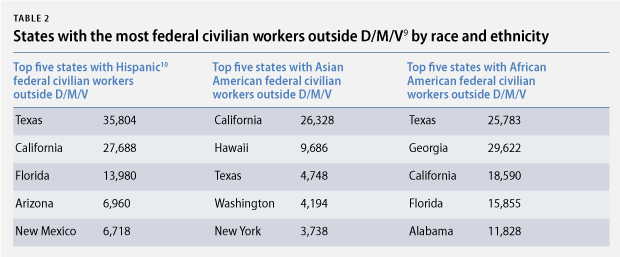Federal employment has traditionally been considered a secure form of employment, one that affords a sense of security to those who choose to become public servants. Most government jobs have good pay and benefits, which can be a good foundation for middle-class incomes; therefore, any loss of government jobs can have a disproportionate effect on the middle class. This is particularly true for African Americans and other people of color, who, after the civil rights gains of the 1960s, saw that public service employment opened up economic opportunities for good, well-paid jobs that provide some measure of protection against discrimination. The competitive pay scales of government employment have lifted generations of black people into the middle class.
While a lot of press attention has been focused on what services the furlough has cut off, there has not been as much attention on who is being affected—particularly in communities of color.
Who are these furloughed employees? Data from the U.S. Office of Personnel Management show there may be up to 150,000 African American, 70,000 Hispanic, and 47,000 Asian American federal employees who have been furloughed.[1] African Americans may be disproportionately affected by the furlough, as government jobs have been more available to them than jobs in the private sector. African Americans hold about 18 percent[2] of federal civilian jobs, while making up around 13 percent of the U.S. population.

While many of the federal employees affected by the furlough reside in the nation’s capital and in nearby Maryland and Virginia, a large share of federal employees reside in the other 47 states; in fact, 78 percent of federal civilian employees do.[5] As such, the federal government shutdown impacts states and localities too. Lost wages translate into decreased spending at the local, state, and national levels. Nationwide, the economy stands to lose an estimated $55 billion if the shutdown lasts for three to four weeks. For states such as California, Florida, and Texas, which have significant numbers of federal employees—and more surprisingly, for states such as Washington and Alabama, which have smaller economies—this could be especially costly.[6] These are also the states that employ some of the largest numbers of people of color in their federal civilian workforces. The 26,328 Asian American federal employees in California, for example, make up nearly 16 percent of the state’s federal civilian employees.[7] Similarly, the 35,804 Hispanic and 25,783 African American federal civilian employees in Texas make up more than 25 percent and more than 18 percent of the state’s federal civilian workers, respectively.[8]

Even though their salaries have not kept pace with inflation, many Americans choose to work in the federal workforce out of a sense of service and a commitment to their country. People of color are not only suffering the consequences of partisan gridlock in Washington but are also bearing the brunt of cuts in services, including delays in obtaining Federal Housing Administration home-buying loans, and economic losses to small businesses that rely on federal workers’ patronage, such as restaurants and lost access to Head Start programs for children.[11] And while the shutdown is already expected to reach $2 billion in economic losses on October 9, the losses to furloughed workers—especially people of color—are similarly destabilizing, especially when one considers how unnecessary the shutdown is.
Farah Ahmad is a Policy Analyst for Progress 2050 at American Progress. She would like to thank Vanessa Cárdenas for her contributions to this column.
Endnotes
[1] Author’s calculations based on an estimated 41 percent furlough rate of “nondefense federal employees” in conjunction with June 2013 data from the FedScope Database. Furlough estimates do not take into account the recent return of some federal civilian employees to the Department of Defense. For the furlough rate, see Raju Chebium, “Question and answers about government shutdown,” USA Today, September 28, 2013, available at http://www.usatoday.com/story/news/politics/2013/09/28/government-shutdown/2885749/. For the FedScope Database data, see U.S. Office of Personnel Management, “FedScope,” available at http://www.fedscope.opm.gov/ (last accessed October 2013). Data refer to all federal civilian employees, including seasonal and part-time workers, except for the exclusions listed here: U.S. Office of Personnel Management, “Data, Analysis & Documentation,” available at http://www.opm.gov/policy-data-oversight/data-analysis-documentation/federal-employment-reports/#url=SDM (last accessed October 2013).
[2] See U.S. Office of Personnel Management, “FedScope.” Data refer to all federal civilian employees, including seasonal and part-time workers, except for the exclusions listed here: U.S. Office of Personnel Management, “Data, Analysis & Documentation.”
[4] Hispanic data include those who identified as Hispanic in combination with another race or more than one race.
[5] Author’s calculations based on June 2013 data from the FedScope Database. See U.S. Office of Personnel Management, “FedScope.” Data refer to all federal civilian employees, including seasonal and part-time workers, except for the exclusions listed here: U.S. Office of Personnel Management, “Data, Analysis & Documentation.”
[7] Author’s calculations based on June 2013 data from the FedScope Database. See endnote 5.
[8] Author’s calculations based on ibid.
[9] “D/M/V” refers to the Washington, D.C., Maryland, and Virginia area that houses the nation’s capital. This disproportionately impacts the number of federal employees in this area.
[10] See endnote 4.
[11] Head Start recently received a private donation of $10 million, which will go directly to Head Start programs in six states—Alabama, Connecticut, Florida, Georgia, Mississippi, and South Carolina—that have closed for lack of funding or are about to run out of money. See John Schwartz, “$10 Million Gift to Help Head Start Through Shutdown,” The New York Times, October 8, 2013, available at http://www.nytimes.com/2013/10/09/us/10-million-gift-to-help-head-start-through-shutdown.html?_r=0.